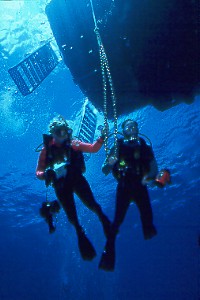There are 6 main islands, mountainous, with a thick tropical rainforest, and hundreds of smaller ones - they have been
inhabited for at least 5000 years.
The first documented European contact was in 1568 by the Spanish, where they discovered alluvial gold, and perhaps
thinking they discovered the source Solomon's wealth, named the islands the "Isle of Solomon's". Subsequent contact
between the islands and the western world was often turbulent, where many islanders were taken to work on plantations
in Fiji and Australia. Many Europeans were killed in retaliation. Headhunting was prevalent until a few decades ago,
resulting in a severe population decline on some islands. The people are largely Melanesian, speaking over 67 languages,
and around a hundred dialects. (Villagers on the same small island, separated only by a few miles, will speak another
dialect or language!) English is the official language, though pidgin English is widely used. Except for the capitol city,
Honiaria, the only mode of transportation is the dugout canoe.
In between the dives, we would stop at different villages, where the residents
exhibited phenomenal skill for wood carving with enlayed shell. We could buy bowls, statuary, and jewelry. A few decades
ago, they were headhunting, but now they live peacefully in villages in thatch houses, growing almost every fruit and
vegetable known to man, fishing and hunting. During the day, they would paddle their dugouts in droves to the boat,
each one having a different vegetable or fruit to sell. We tried to buy at least one item from each canoe. We ate like
kings on the boat, mostly due to the largess brought by the villagers. Our chefs were locals and cooked fantastic meals.
Because the villages owned the reefs, the boat charter company had to get permission from the chiefs to dive the reefs.
By doing so, the villages also had an outlet for their carvings and produce. We also got to see village life and talk to
the locals- a very friendly, happy people. They may not have had many material things, but they are so rich in life. One
of the biggest medical problems they have is malaria. It is too expensive to treat it propholactically, they will only
treat it when it becomes acute. Malaria is one of their biggest killers. They have also become very AIDS aware, as that
has become more prevalent.
One of my favorite places was the Morovo Lagoon- a magical place surrounded by volcanic mountains and rainforest.
This is where I photographed the mandarinfish spawning! We found a real treasure there in the Peava Village, where the
Wilderness Lodge is located. A land based diving operation, run by the villagers takes about 8 divers in the Lodge, in
two large rooms. The facilities are simple, but more than adequate and comfortable. The open air Lodge has a spacious
dining area and place to relax after your dives. Most people become engaged in the village life, but there is birding,
snorkeling and bushwalks. The dive operation, Solomon Dive Adventures, is run by locals, all instructors and
divemasters were trained by an American woman- Lisa Choquette, (President of SDA) who got a grant to make this whole
operation happen. The villagers are becoming more self sufficient, and are able to have control of their own lands and
waters. It becomes clear to them, they can earn more showing tourists their outstanding reefs, than by overfishing. This
was one of the "richest" villages we visited- and not just in material wealth, but in education, health care,
environmental awareness- all brought by Lisa and her hard work.
For more information on the Wilderness Lodge
contact Lisa at www.solomondiveadventures.com
and www.thewildernesslodge.org
Email Lisa at lisa@solomondiveadventures.com
This was a trip of a lifetime for us, and it re-enforced for us the fact that we have so much of our underwater
world and cultures yet to see and experience. It also reaffirmed to us how much of the world gets by on very little,
and happiness has nothing to do with material things. We plan to go back as soon as we can.
See you there!
___________________________________



